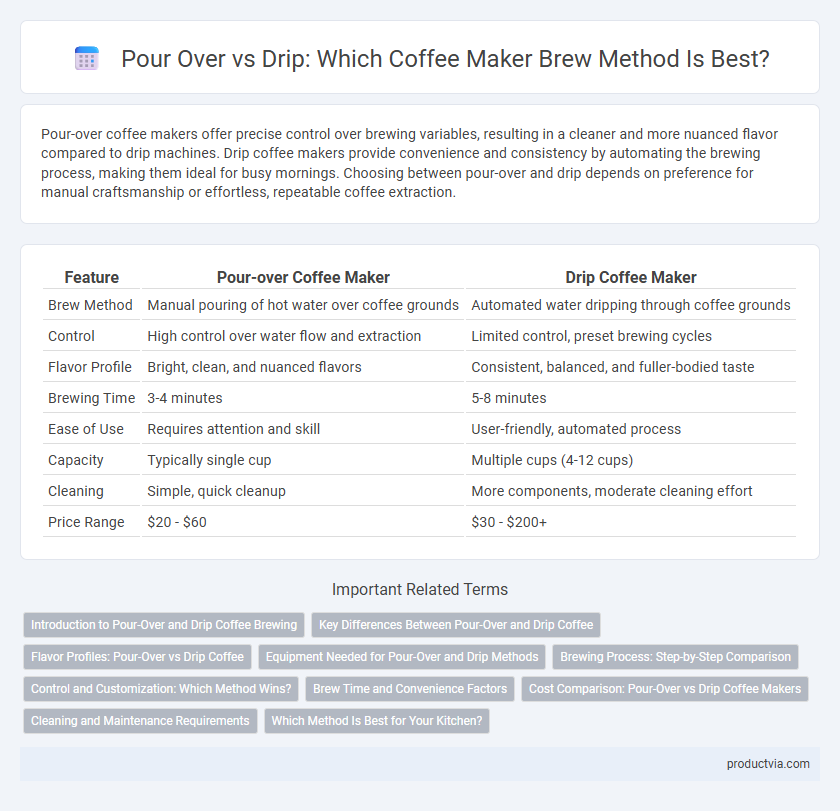Pour-over coffee makers offer precise control over brewing variables, resulting in a cleaner and more nuanced flavor compared to drip machines. Drip coffee makers provide convenience and consistency by automating the brewing process, making them ideal for busy mornings. Choosing between pour-over and drip depends on preference for manual craftsmanship or effortless, repeatable coffee extraction.
Table of Comparison
| Feature | Pour-over Coffee Maker | Drip Coffee Maker |
|---|---|---|
| Brew Method | Manual pouring of hot water over coffee grounds | Automated water dripping through coffee grounds |
| Control | High control over water flow and extraction | Limited control, preset brewing cycles |
| Flavor Profile | Bright, clean, and nuanced flavors | Consistent, balanced, and fuller-bodied taste |
| Brewing Time | 3-4 minutes | 5-8 minutes |
| Ease of Use | Requires attention and skill | User-friendly, automated process |
| Capacity | Typically single cup | Multiple cups (4-12 cups) |
| Cleaning | Simple, quick cleanup | More components, moderate cleaning effort |
| Price Range | $20 - $60 | $30 - $200+ |
Introduction to Pour-Over and Drip Coffee Brewing
Pour-over coffee brewing involves manually pouring hot water over coffee grounds in a cone-shaped filter, allowing precise control over extraction time and water temperature, resulting in a flavorful and aromatic cup. Drip coffee brewing uses an automatic machine that passes hot water through coffee grounds in a paper or metal filter, offering convenience and consistency for everyday use. Both methods rely on gravity to filter coffee but differ significantly in control and brewing experience.
Key Differences Between Pour-Over and Drip Coffee
Pour-over coffee offers precise control over brewing variables such as water temperature, pour rate, and saturation, resulting in a cleaner, more nuanced flavor profile compared to drip coffee. Drip coffee makers automate the process, providing convenience and consistency but typically produce a less vibrant cup due to faster extraction and less control over brewing parameters. The key difference lies in manual intervention and extraction control, with pour-over favored by enthusiasts seeking customized brewing and drip preferred for ease and volume.
Flavor Profiles: Pour-Over vs Drip Coffee
Pour-over coffee delivers a cleaner, more nuanced flavor profile by allowing precise control over extraction time and water temperature, highlighting bright acidity and complex notes. Drip coffee offers a consistent, bolder taste with a fuller body, producing a balanced cup suited for everyday consumption. The pour-over method is favored by enthusiasts seeking intricate flavors, while drip machines provide convenience and reliable results.
Equipment Needed for Pour-Over and Drip Methods
Pour-over brewing requires a cone-shaped filter, a gooseneck kettle for precise water pouring, and often a glass or ceramic dripper, enabling manual control of extraction time and temperature. Drip coffee makers consist of an electric machine with a built-in water reservoir, heating element, and a basket to hold paper or permanent filters, automating the brewing process with consistent temperature and timing. Equipment choice impacts flavor clarity and brewing convenience, with pour-over demanding more hands-on tools and drip offering streamlined, set-and-forget functionality.
Brewing Process: Step-by-Step Comparison
The pour-over brewing process involves manually pouring hot water over coffee grounds in slow, circular motions, allowing precise control over extraction time and water distribution. In contrast, the drip method automates water flow through a filter, delivering a consistent but less customizable brewing experience. Pour-over typically requires more attention and time, whereas drip offers convenience and speed with reliable results.
Control and Customization: Which Method Wins?
Pour-over coffee makers offer unparalleled control over brewing variables such as water temperature, pour rate, and extraction time, allowing enthusiasts to tailor the flavor profile precisely. Drip coffee makers provide convenience with automated brewing cycles but lack the granular customization for factors like bloom and flow rate. For those prioritizing control and customization, pour-over methods consistently deliver a superior, hands-on brewing experience compared to drip coffee machines.
Brew Time and Convenience Factors
Pour-over coffee makers typically require 3 to 4 minutes of brewing time, offering precise control over water flow and extraction for a richer flavor profile. Drip coffee makers automate the process, brewing a full carafe in around 5 to 8 minutes, making them more convenient for busy mornings or multiple servings. The manual nature of pour-over demands attention and skill, while drip machines offer easy operation and programmable features for consistent results.
Cost Comparison: Pour-Over vs Drip Coffee Makers
Pour-over coffee makers typically have a lower upfront cost, ranging from $20 to $50, while drip coffee makers vary between $40 and $200 depending on features and capacity. Pour-over devices require minimal maintenance and no electricity, reducing long-term operational expenses compared to drip machines that consume power and may incur repair costs. Choosing between the two depends on budget flexibility and preferences for convenience versus manual control.
Cleaning and Maintenance Requirements
Pour-over coffee makers require minimal cleaning, usually just rinsing the dripper and replacing disposable filters after each use. Drip coffee machines often have more parts like the carafe, basket, and water reservoir, demanding regular deep cleaning to prevent buildup and maintain brew quality. Proper maintenance of both methods extends appliance lifespan and ensures optimal flavor extraction.
Which Method Is Best for Your Kitchen?
Pour-over coffee makers deliver precise control over brewing variables, resulting in a cleaner, more nuanced cup ideal for coffee enthusiasts who enjoy experimenting with flavors. Drip coffee makers offer convenience and speed, making them the best choice for busy kitchens or larger households where volume and ease of use are priorities. Selecting the best brew method depends on your preference for customization versus functionality, kitchen space, and daily coffee consumption habits.
Pour-over vs Drip for Brew Method Infographic

 productvia.com
productvia.com